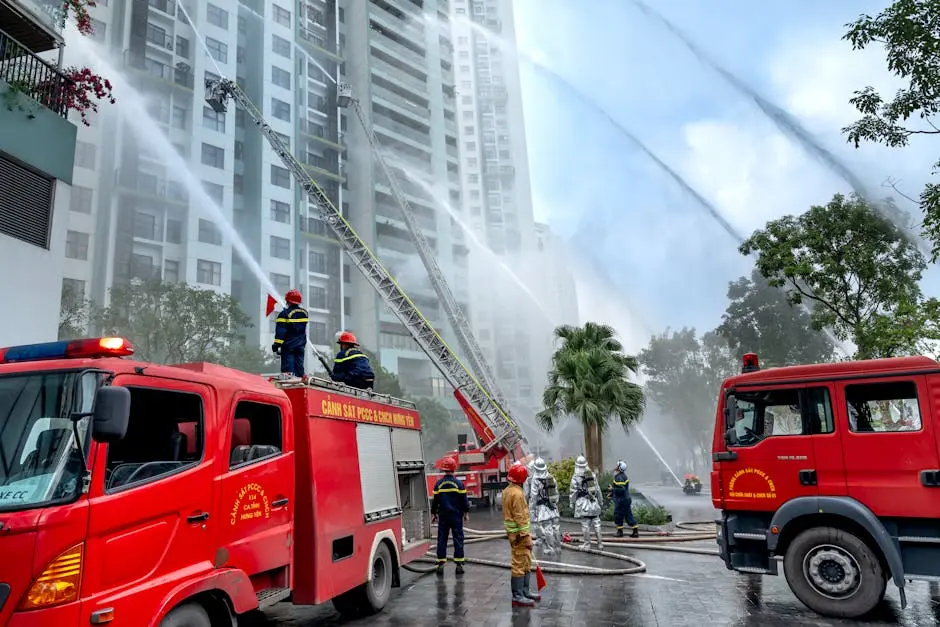Homeowners’ Associations (HOAs) play a crucial role in maintaining the safety and wellbeing of communities. When it comes to fire safety preparedness, HOAs can make a significant impact. In this blog, we’ll explore how HOAs contribute to reducing fire risks and ensuring that communities are well-prepared in case of a fire emergency.
Understanding the Importance of Fire Safety for HOAs
Fire safety is a critical aspect of community management. HOAs must prioritize fire safety to protect both residents and property investments. Understanding the risks and taking preventive action is essential for the wellbeing of all community members. Fires not only cause devastating physical damage but also lead to emotional and financial turmoil. HOAs are in a unique position to implement preventative measures that can save lives and property.
The rise in global temperatures and changing climate patterns have contributed to an increased frequency of fires in many regions. This makes it even more crucial for communities to be vigilant. For example, the integration of fire-safe materials in construction and landscaping practices can dramatically reduce the spread of fires. HOAs are urged to consider these factors in neighborhood development and maintenance plans.
Furthermore, when communities prioritize fire safety, they foster a culture of preparedness that resonates throughout their neighborhood. Preventative measures, such as regularly cleaning green spaces and maintaining accessible roads for emergency vehicles, further strengthen this culture. Importantly, fire safety initiatives can lower insurance premiums, highlighting a practical financial incentive, in addition to safety benefits, that HOAs should consider.
Implementing Fire Safety Measures
From installing fire extinguishers to ensuring clear evacuation routes, HOAs can implement a variety of measures to enhance fire safety. Regular maintenance checks and fire drills are also vital components of a comprehensive fire safety plan. Fire extinguishers should be readily available, and proper signage indicating escape routes must be visible. These simple but essential steps can make a significant difference in the event of an emergency.
Moreover, HOAs can invest in advanced fire detection systems that offer early warnings even before flames are visible. These systems often utilize smoke, heat, and carbon monoxide detectors to provide comprehensive alerts. Implementing such solutions not only provides peace of mind but can significantly increase response times during a fire emergency.
Maintenance of property exteriors plays a crucial role too. Clearing gutters of dry leaves and ensuring that roofs are debris-free are simple tasks that can prevent potential fire hazards. Landscaping with fire-resistant plants and maintaining ample space between them can further minimize risks. Regular communication from HOAs to residents regarding seasonal maintenance can promote a collaborative effort towards safety.
Fire safety is not a one-time task but an ongoing commitment. By creating a routine schedule for inspections and safety measures, HOAs ensure continuous awareness and readiness. It helps in identifying any lapses in safety and allows for timely corrections. This can be supported by engaging experts who can conduct periodic evaluations and suggest improvements tailored to specific community needs.
Educating Residents on Fire Safety
Community education is a powerful tool. HOAs can organize workshops and distribute materials to inform residents about fire hazards and safety practices. Empowering residents with knowledge can significantly reduce fire risks. By organizing regular information sessions, residents can learn how to use fire extinguishers and what to do in case of a fire, making individuals proactive rather than reactive.
Interactive training sessions, such as those led by local fire departments, can dramatically increase resident engagement. These sessions allow residents to practice what they have learned, building confidence in their ability to respond to actual emergencies. Further, HOAs can collaborate with experts to develop educational materials that are easily accessible and understandable, such as brochures, videos, and online resources.
Celebrating successful safety practices and highlighting proactive measures taken by community members can spur wider participation. Initiatives like these reinforce a sense of responsibility among residents and promote a collective approach towards safety. Encouraging feedback and suggestions on improving education initiatives can also tailor programs, making them more effective in addressing unique community needs.
Collaborating with Local Fire Departments
Building strong relationships with local fire departments can aid in better fire preparedness. HOAs can coordinate with fire professionals for inspections and training sessions, ensuring that the community is equipped to handle fire emergencies. These partnerships can lead to valuable insights regarding specific fire threats and recommended safety measures.
Some fire departments offer community outreach programs that include fire safety demonstrations and workshops. Attending these events not only educates residents but also opens lines of communication with first responders. Knowing who to contact and how they will respond during an emergency is crucial.
Developing a Community Fire Emergency Plan
An effective emergency plan outlines clear roles and procedures in the event of a fire. HOAs should work with residents to develop and regularly update their community fire emergency plans. This ensures everyone knows what to do if a fire occurs. It involves defining evacuation routes, establishing meeting points, and assigning roles to ensure swift and organized evacuations. A community-wide emergency plan fosters unity and ensures safety is a shared priority.
Regularly scheduled drills should test the effectiveness of these plans, allowing HOAs to gather feedback and make necessary adjustments. Implementing a feedback mechanism where residents can offer suggestions and raise concerns helps refine these plans over time. Furthermore, clear communication channels, such as community apps or newsletters, can keep everyone informed of any updates to the emergency procedures.
Empowering Communities Through Fire Safety
By implementing comprehensive fire safety measures, HOAs not only protect properties but also enhance the overall safety and security of their communities. Through informed planning and active participation, they create environments where residents can feel secure. Remember, fire safety is a shared responsibility, and proactive measures by HOAs can make a significant difference. For more information on how you can get involved, visit our homepage and take the first step in fire safety preparedness.





